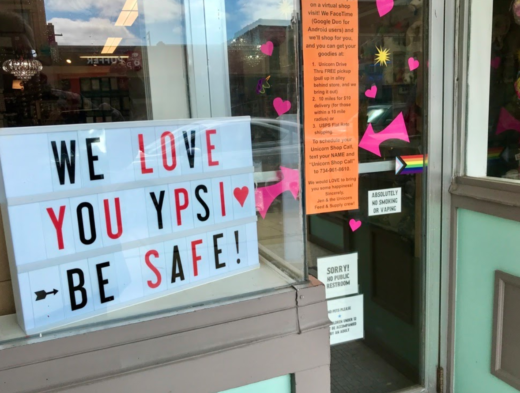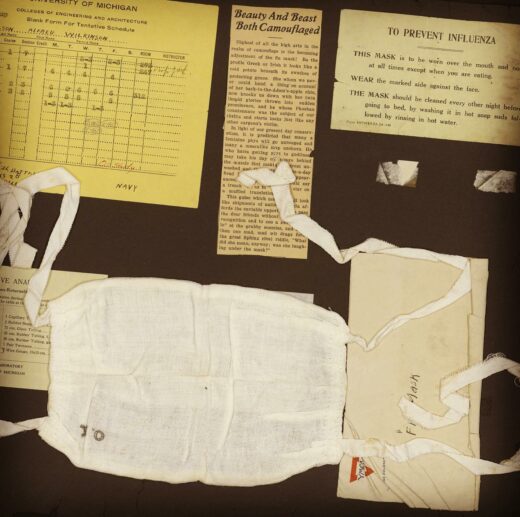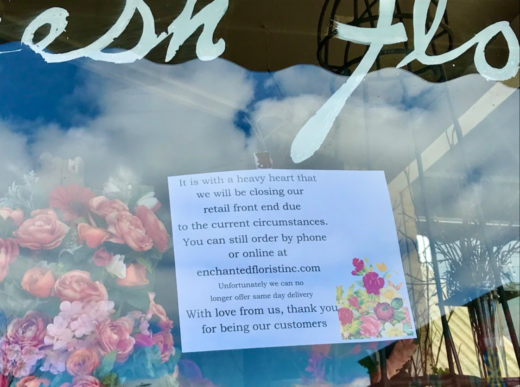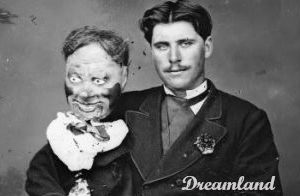Back in 2017, I got the idea that we should designate a weekend to collectively documenting our lives in Ypsilanti. I called the initiative #DocumentYpsi, and the results were pretty awesome. In fact, I was 100% committed, given the response, to make sure that it became an annual thing. But, like so many other things, I just forgot about it… until today… when I got word from my friend Kim Clarke that she wants to do something similar in conjunction with the Ypsilanti Historical Society, where she serves on the archive advisory board. Specifically, she wants to be sure that the archive accurately reflects what life in Ypsilanti was like during the COVID-19 lockdown of 2020. So, with that in mind, I’ve asked her to join me for a virtual beer to discuss what she has in mind, and how readers of this site might be able to help.

MARK: If you’re cool with it, I was thinking that we could start by talking about your day job, mining the U-M historical archives… You’ve been spending a lot of time these last several years, digging through archival materials, and I’m curious as to how it’s informed your perspective on the present… I mean, do you ever consider what someone doing your job 100 years from now might find themselves struggling to understand?
KIM: I spend a good deal of time at the Bentley Historical Archives. My job is managing a narrative website called the U-M Heritage Project, where we research and develop stories about the people and events that have shaped the institution through the years. The Bentley has terrific resources, both in terms of archival documents and images. We couldn’t do our site without the Bentley’s materials.
But, as I suspect is the case with anyone who does historical research, I always want to know more about daily life and the everyday person. I bet the archivists at the Bentley feel the same way.
So, for example, if the president of the university bans automobiles on campus because too many accidents are occuring, what did students think about that? That happened in 1925, when cars and traffic management were still a bit of a novelty. We can look at the Michigan Daily archives for some student insights. But wouldn’t it be great to have diaries from students, or letters home saying, “Hey, Dad, come and get the roadster, because I can’t have it on campus anymore.”
And there are definitely letters, scrapbooks and journals in the archives. I’m just greedy and want more.
MARK: I’m curious what you found in the U-M archives about the flu of 1918, assuming you’ve looked. Was there much?
KIM: I confess I have not done a deep dive into the 1918 epidemic. I know from others’ work that it crippled the campus and Ann Arbor. The epidemic coincided with America’s entry into the Great War, and students were allowed to join what was known as the Student Army Training Corps. It was similar to today’s ROTC programs. Just as the flu was spreading, SATC recruits were housed in the Michigan Union, which was new and had yet to open the public. We know now that infection disease and close quarters are a deadly mix. So when the flu hit Ann Arbor, 57 SATC recruits died.
President Harry Hutchins ordered all students and faculty to wear masks, and you can find one of those masks at the Bentley in a student scrapbook. Large gatherings were banned throughout the city. Enrico Caruso was scheduled to perform at Hill Auditorium, and was forced to cancel.

[Caption from the Bentley: “All U-M faculty and students were ordered to wear face masks in the fall of 1918 during a global influenza outbreak post-World War I. U-M student Alfred Wilkinson Wilson kept his in a scrapbook now housed at the Bentley, along with the mask’s directions for use. Influenza and pneumonia killed more than 15,000 people in Michigan between October 1918 and April 1919, with the highest death rate among people in their 20s.”]
MARK: I think, because of cell phones, the pervasiveness of camera technology, and our selfie-centric culture, there’s a sense that everything is being recorded, and that the job of future historians is going to be relatively easy with regard to what you’re talking about. I suspect, however, the opposite may be true. The glut of material, I’m thinking, could be absolutely impossible to wade through.
KIM: There is a glut. But at the same time, if the photos – and the texts and the emails and the emojis – never leave your phone, tomorrow’s historians will never know about them.
MARK: Oh, I’m just assuming that everything I do online has been captured by someone. I doubt they’re well-intentioned people looking out for future historians and sociologists, though. More likely, they’re people like Mark Zuckerberg, looking to monetize it. Still, though, I suspect that, if humanity exists into the future, it’ll be out there, and our ancestors, for a price, will be able to find out every cringeworthy Lifetime movie we ever watched, and every sexualy-suggestive emoji we ever sent. I guess that’s one good thing to be said for extinction.
KIM: Right. We’re going to see a lot of bad photos of what people had for dinner. I guess culinary historians will appreciate it.
MARK: So, what made you think, “We need to document what’s going on right now in Ypsilanti”?
KIM: I went for a walk around town this past Saturday (March 21) and was struck by all the handmade signs taped to storefronts. Owners saying they were closed, or cutting back hours, or working online only. It was pretty heartbreaking, but at the same time, so many of the signs had such grace. The Enchanted Florist had a beautiful sign. So did Unicorn Feed and Supply. These are businesses that are closing their doors and who knows if and when they will re-open. And still, the owners were thanking customers, encouraging good health, and looking ahead. I just thought: We need to capture this. And you don’t have to be a business owner to have had your world turned upside down right now.

MARK: And then you ran the idea by the folks at the Historical Society?
KIM: Yes. I reached out to Bill Nickels, who is president of the Ypsilanti Historical Society, and asked what he thought about creating a visual archive and asking people to share their photos. He liked the idea and so here we are. I created a Facebook group and hope people will show what’s happening in their world during this crazy time. I also hope it might be a way for people to connect, because life is pretty isolated right now.
MARK: Both you and he are to be commended. I seem to recall a time, not long ago, when I heard that people were trying to get their local historical archives to start Occupy Wall Street collections to no avail. I think the sense back then was that it wasn’t the place of archives to get involved in the present. Or at least that’s the sense I got, having talked with a friend who is an archivist in New York City. He, by the way, was successful in getting his institution to archive materials from both the Women’s March and Occupy Wall Street, but it took some doing… The role of a local history archive in the present is an interesting one to debate.
KIM: Exactly. National stories and movements will be recorded from many angles by different entities. But capturing local events often is in the hands of citizens, particularly with the demise of local newspapers. So I hope people will approach this as if it is 2120 and their grandchildren are wondering what the coronavirus epidemic of 2020 was like in Ypsilanti. Let’s provide a snapshot for them.
MARK: What kind of response have you gotten thus far from the community? Anything that you weren’t expecting?
KIM: About 90 people have joined the group so far, and I hope it grows. Folks have shared pictures from around town – a pretty desolate town. We have a video clip from a nature walk. One woman is in isolation and shared a photo from her bed. That was sobering. All of these images are exactly the kind of scenes I hope people will contribute: their perspectives during this time.
As I described in setting up the page, share anything that captures this moment in time: Stocking the pantry, videochats with co-workers, jigsaw puzzles with your kids, layoff notices, social distancing in the park, your Netflix watchlist.
MARK: I’ll have to check Governor Whitmer’s shelter-in-place order, but I don’t believe there’s an exception for “documenting the desolation.”
KIM: Going outside for a run or to walk the dog is allowed and encouraged. So why not get out of the house for a bit and take a few photos for the archives while you’re at it? Seems like a win-win to me.
[If you should take pictures for this, and you share them on social media, please post a link in this thread, or just send me the photos and I’ll find a way to share them.]












5 Comments
This is a wonderful and beautiful distraction from the pain and misery of everyday life. Thank you, Kim.
Wonderful interview!!
I am doing something similar with Ann Arbor–deep dive into archives. I talked to Lucy Ann last week: http://www.lucyannlance.com/audio/031620/washremembered.mp3?fbclid=IwAR09HaJjr7hnqxu2kWtzA2gy7hjtgDBpZmJ2RpydrvstxnocjqWsc850_M4
I imagine the images that are submitted now and going to be quite a bit different than the ones submitted one month from now. Now there’s probably still some happiness, as families gather around the fireplace to drink coco and things like that. In a month, I’m guessing the novelty will have word out.
Pro tip. Next time, lead with the happy story. Putting this after the “we’re having to choose who lives and who dies” post was probably not that smart. Did Casey Kasem teach you nothing?
https://www.youtube.com/watch?v=ndUk6yX3PBo